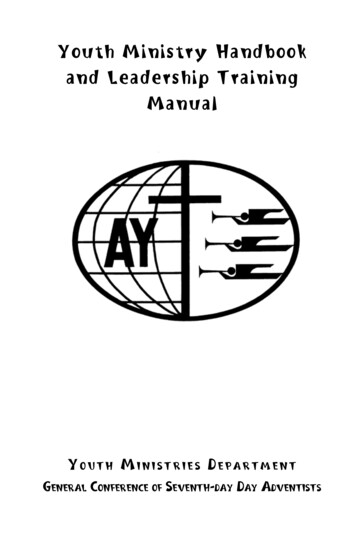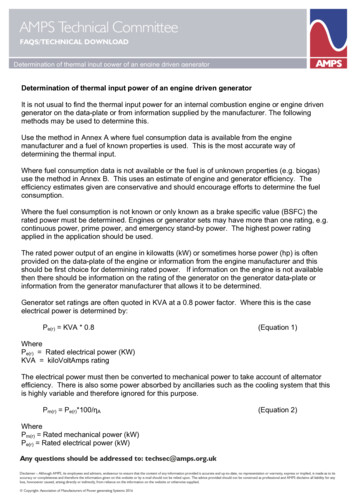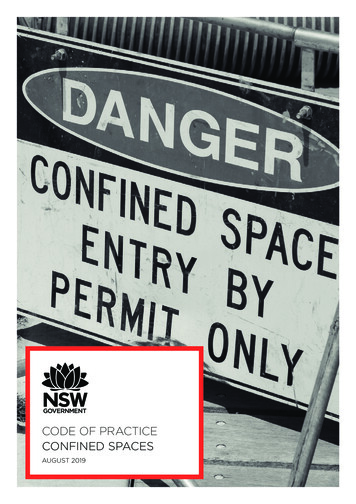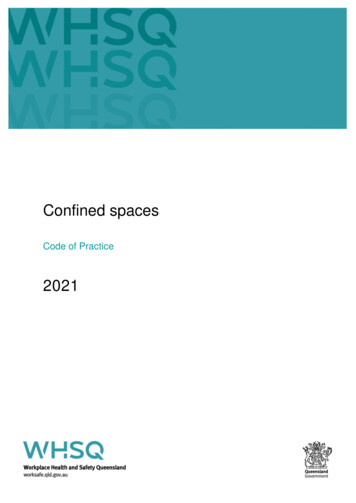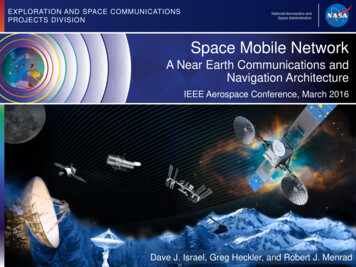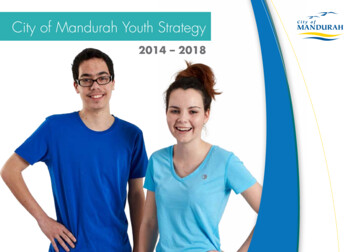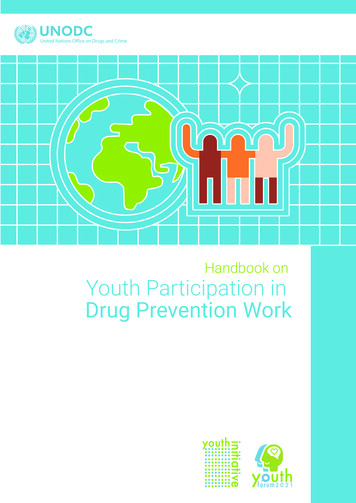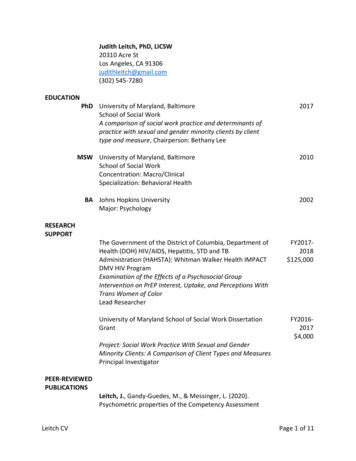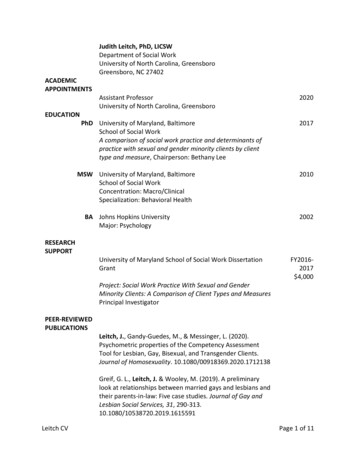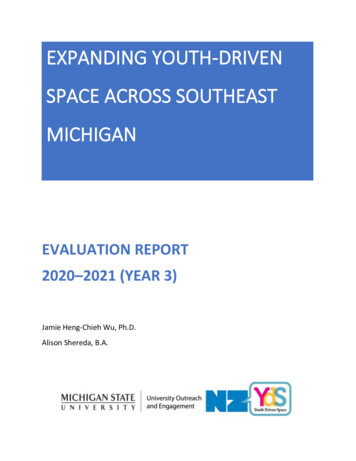
Transcription
EXPANDING YOUTH-DRIVENSPACE ACROSS SOUTHEASTMICHIGANEVALUATION REPORT2020–2021 (YEAR 3)Jamie Heng-Chieh Wu, Ph.D.Alison Shereda, B.A.
TABLE OF CONTENTSEVALUATION OVERVIEW . iOUTLINE OF CONTENT .iiDELIVERY OF ONE-ON-ONE YDS COACHING . 1Participating Organizations . 1Impact of COVID-19 on YDS Organizations . 3The Motives for Organizations to Get Involved with (Virtual) YDS Coaching . 3Useful YDS Resources and Activities . 4DELIVERY OF THE VIRTUAL COACHES TRAINING . 7Organization Information . 7(Virtual) Group Norms . 8Community-Building Activities . 9Three Pillars of YDS . 10Restorative Practice . 15Misconceptions, Perceptions, and Corrections . 15Social Identity Brainstorming . 16Effective Youth Program Training . 17Youth Advisory Council: Benefits . 19Youth Advisory Council: Stages . 20Staff Participants’ Reflections on the Virtual Training . 21Virtual Training Evaluation . 22YDS CONFERENCE . 24Funding Pitches . 24Workshops. 26Conference Evaluation . 27UNDERSTANDING THE VIRTUAL COACHING EXPERIENCE . 30YDS Program Staff Feedback . 30Neutral Zone Coach Feedback . 32
LOOKING BACK: EXPANDING YOUTH-DRIVEN SPACE IN SOUTHEAST MICHIGAN, 2018–2021 . 37Why This Work Is Valuable . 37The Important Components of YDS . 38Challenges . 39The Future of YDS . 39CONTACT INFORMATION . 40
FIGURES & TABLESFigure 1: Virtual Coaches Training Group Norms . 8Figure 2: Three Pillars of YDS . 10Figure 3: Youth-Adult Partnerships Brainstorm. 14Figure 4: Social Identity Brainstorming . 16Figure 5: Characteristics of a Bad Meeting . 17Figure 6: Characteristics of a Good Meeting . 18Figure 7: Stages of Formation of a Youth Advisory Council. 20Figure 8: Virtual Training Word Cloud . 22Figure 9: YDS Training Evaluation Ratings . 23Figure 10: YDS Training Evaluation Responses About Effectiveness . 23Figure 11: Pitch Presentation Slide, Congress of Communities . 24Figure 12: Pitch Presentation Slide, Ypsilanti District Library . 25Figure 13: Three-Step Philanthropic Process, Teen Grantmaking Initiative. 26Figure 14: Elements of a Movement, Detroit Heals Detroit . 27Figure 15: Conference Ratings . 28Figure 16: YDS Conference Word Cloud . 29Table 1: Organizations That Received One-on-One Coaching Support . 1Table 2: Organizations That Received Group Training . 7Table 3: Four Components to Support Youth's Intrinsic Motivation . 11Table 4: Strategies to Support Youths’ Seven Developmental Needs . 12Table 5: Misconceptions, Perceptions, and Corrections Responses . 15Table 6: Benefits of Youth Advisory Councils . 19Table 7: YDS Conference Evaluation Responses . 28Table 8: YDS Conference Participant Highlights . 29
EVALUATION OVERVIEWThe Evaluation of Expanding Youth-Driven Space Across Southeast Michigan is a three-yearproject, beginning in summer 2018, with funding support from the Ralph C. Wilson, Jr.,Foundation. Youth-driven space (YDS) refers to a positive youth-development environmentwhere young people partner with adults to meaningfully engage in decision-making throughoutthe organization’s governance and programming activities. YDS involves three core practices:tapping teens’ intrinsic motivation, supporting teens’ developmental needs, and fostering genuinepartnerships between adults and youth. This initiative is led by the Neutral Zone, a youth-driventeen center in Ann Arbor, Michigan, that is dedicated to providing social, cultural, educational,recreational, and creative opportunities for high-school teens. Through this project, participatingyouth-serving agencies receive intensive coaching and training supports to promote youthleadership, social-emotional learning, and effective school and community change.Since 2010, Michigan State University’s Outreach and Engagement (UOE) has established anextensive and mutually beneficial partnership with the Neutral Zone, with a common goal toempower youth in communities across Michigan. The objective for this current initiative istwofold: (1) to support the Neutral Zone and the participating agencies with timely feedback socoaching and training efforts can best be utilized and (2) to identify best practices and effectiveways of enhancing youths’ experience in engaging in meaningful decision-making, identifyingmentors, co-learning with adults, and feeling connected to their organizations and the communityat large. These experiences represent the four key aspects of youth-adult partnerships and arealigned with high-quality program standards. Working together with the Neutral Zone, our goalis to transform these organizations into YDS model sites where teens are able to find a voicewithin themselves and in their organizations and local communities.Because the COVID-19 pandemic continued throughout the 2020–2021 program year, programswere integrating virtual models and some in-person supports to serve youth in their communities.Neutral Zone adapted its processes to be fully online, working with adult staff and youth fromthe participating organizations across the region. This Year 3 evaluation report documents someof the major activities during the third and final year of the initiative. The third cohort includessix organizations that have received individualized one-on-one virtual coaching, as well as staffand youth from nine organizations that have participated in group virtual trainings led bycoaches.This report is organized under four themes: Individual Coaching Sessions, Group VirtualCoaches Trainings, YDS Conference, and Understanding the Virtual Coaching Experience.The report concludes with lessons learned from the coaches and staff from participatingorganizations over the past three years.i
OUTLINE OF CONTENTIndividual Coaching SessionsIn one-on-one sessions, Neutral Zone coaches worked with individual youth-servingorganizations.Virtual Coaches TrainingsFrom December 2020 to May 2021, the Neutral Zone hosted monthly Zoom calls with programstaff from nine organization, adding two youth apiece from those organizations after the first fewsessions. These calls aimed to equip organizations with resources and tools to expand YDS intheir programs.YDS ConferenceThe virtual YDS Conference allowed youth from programs across southeast Michigan to presentpitches and receive small grants from the Neutral Zone in order to finance their initiatives.During the second half of the conference, three youth-serving organizations presented workshopsfor conference attendees.Understanding the Virtual Coaching ExperienceWe collected qualitative data in interviews with program staff and Neutral Zone coaches on theindividual organizational coaching and large-group training conducted by coaches.Looking Back: Three Years of Expanding Youth-Driven Space in Southeast MichiganThis section presents an overview of the interventions conducted over the past three years, themost successful and challenging components of the initiative, and the opportunities for furtherexpanding YDS and youth leadership.ii
DELIVERY OF ONE-ON-ONE YDS COACHINGFrom October 2020 to June 2021, staff members from the Neutral Zone served as coaches to sixdifferent organizations across southeast Michigan. These virtual sessions, largely occurringbetween Neutral Zone coaches and program staff, aimed to provide individualized assistance,support, and resources to enhance YDS.Participating OrganizationsTable 1 summarizes information about the organizations that received virtual coaching.Table 1: Organizations That Received One-on-One Coaching SupportOrganizationNameCommon GroundAgeGroup10–24Detroit HorsePower10–18DetroitLeadership wntown BoxingGym8–18Number ofMission StatementYouth120 “Common Ground is a 24-hour crisisservices agency dedicated to helping youth,adults, and families in crisis. Through ourcrisis line and in-person, we provideprofessional and compassionate service tomore than 80,000 people each year.”100“To give at-risk youth a safe and enrichingsummer,space that furthers their development. We30–35believe that horses can teach childrenafterschool critical life skills and have developed asocial-emotional learning program thatfocuses on the traits of perseverance,empathy, responsible risk-taking,confidence, and self-control.”24“For many Detroit youth, green spaces areinaccessible, local opportunities to connectto the natural world are scarce and STEMeducation lacks local context. To helpbridge this gap, the Detroit Leadership andEnvironmental Education Program (DLEEP) strengthens relationships betweenhigh school students and their families withthe natural world in Detroit and beyond.”150 “Through education, athletics, mentorship,and intervention, the Downtown BoxingGym empowers Detroit students to bepositive and productive members ofsociety.”1
OrganizationNameGeneration ofPromiseGrowing HopeAgeNumber ofGroupYouth16-17 (high 60schooljuniors andseniors)15–1815 summer,10 afterschoolMission Statement“To develop a community of young leadersfrom across metropolitan Detroit who honordiversity and are dedicated to theelimination of discrimination.”“Growing Hope fosters an equitable andsustainable local food system where allpeople are empowered to grow, sell, buy,prepare, and eat nourishing food.”Although most meetings between Neutral Zone coaches and program staff served as progresscheck-ins, programs also received coaching on the following topics: Strategic planning and goal settingYouth skills developmentDevelopment of “quick win” projectsTraining in youth engagement and youth-adult partnershipsCurriculum and lesson plan developmentDevelopment of an annual cycle of skill buildingPutting youth on the board of directorsThe goal of coaching, as stated by a Neutral Zone coach, is “being a support and a resource toorganizations to help them figure out what their goals are and to help them get there, whetherthat’s through training, conversations, workshops, strategy sessions, brainstorming, etc.”To better understand the virtual coaching experience, as well as the benefits ofhosting virtual coaching sessions and YDS, MSU evaluators conducted semistructured interviews with four individual staff members from the participatingorganizations in this cohort, whom we label as Staff 1, 2, 3, and 4. Subsequently,we conducted semi-structured interviews with four Neutral Zone coaches whopioneered the organization’s virtual coaching initiatives; they are identified asCoach 1, 2, 3, and 4.2
Impact of COVID-19 on YDS OrganizationsTo comply with safety guidelines instituted by the Centers for Disease Control and Prevention(CDC) and the State of Michigan, all coaching sessions were conducted virtually, using Zoom,emails, or phone calls. Before the COVID-19pandemic, all coaching offered by the NeutralZone was in person. Virtual coaching wascompletely new this year. Participatingorganizations worked throughout the pandemic toadapt their programs to continue to educate andengage youth, while also keeping them safe.For Staff 1’s program, everything went virtual. Theorganization was able to maintain its year-longprogram, which meets monthly. It reduced the size of its cohort for this year because managing alarge virtual space is difficult. As a relationship-driven program, organization leaders believedthat a smaller group of students would more easily get to know one another. Additionally, theprogram integrated virtual security measures in order to combat “Zoom bombing.”Staff 2’s organization continued teen programming outdoors and in-person (in compliance withCDC guidelines); however, Staff 2 expressed difficulties with icebreakers and team-buildingactivities. Throughout the pandemic, the program continued to offer field trips and afterschoolprogramming at a lower-than-usual capacity to respond to community needs.According to Staff 3, their program wanted to continue to serve youth in the best way possible.One of the biggest problems due to the pandemic in their community was the loss of childcare.Because many parents were essential workers, their kids needed supervision throughout the day.Complying with CDC and state safety measures, Staff 3’s program used its facility as a spacewhere younger youth could do safe, in-person, synchronous learning, complete with socialemotional and academic support. The program offered virtual and in-person tutoring and openedits space to give youth food, resources, and a safe place with adult supervision.Staff 4 stated that their program had to reduce capacity in order to comply with social distancingand that it received government support to fund a regular cleaning crew to disinfect the spacemultiple times a week. Additionally, many program services, as well as youth leadership councilmeetings, shifted from in person to virtual.The Motives for Organizations to Get Involved with (Virtual) YDS CoachingStaff 1 initially got involved with YDS training because, being from a youth-focused program,they “wanted to become more youth-driven than a more ‘traditional’ organization.” Fostering aYDS aligned with their board’s goals and allowed for flexibility and creativity.Staff 2, who had experience with the Neutral Zone in a previous position, witnessed issues withtheir current organization’s teen programming and knew that more support was needed. Theorganization needed support in the process of starting an afterschool program. In particular, Staff2 found that many youth struggled to find the right balance between taking on meaningfulresponsibilities and simply relaxing and having fun.3
The goal of Staff 3’s program was tobe more youth focused and have youthin more leadership roles, so thecollaboration with the Neutral Zonewas a natural fit. Staff 3 stated that “asan afterschool non-profit, attendance isdifferent every day. It’s difficult to putstudents in leadership, but youthshould be involved in decisions andprogramming.” In light of problemsolving and other obstacles, Staff 3reported that YDS has been great atproviding support.According to Staff 4, their organization’s youth leadership council did not exist before theyjoined the organization. Their position transitioned from part-time to full-time in order toenhance staff capacity and enable Staff 4 to serve as a staff liaison to a youth council. Becausethis youth council is in its infancy in YDS terms, Staff 4 said they “needed support and help frompeople who have done this before in the community.” Because the coaching was offered at noextra cost, Staff 4 and their organization was able to participate in this intervention.Useful YDS Resources and ActivitiesReflections from Coaching RecipientsStaff 1 and their program enjoyed an exercise where they learned about the developmentalneeds of young people and brainstormed ways to meet each of the seven developmental needs.The organization’s board members frequently revisit this activity and have found it “good tohave a concrete list of things to meet the needs of youth.” Additionally, staff regularly used theCircle App during community-building exercises, with great success. Post-pandemic, Staff 1stated that strategies that strengthen youth-adult partnerships would be useful—particularlyhaving adults think through their advantages over young people. They also stated that, for youthboard members, they plan to use an exercise that presents youth with multiple tasks, and theyouth decide whether each task is the responsibility of the board or the program staff.Staff 2 spoke highly of a fill-in-the-blank agenda provided by the Neutral Zone for teens tocreate their own workshops. Additionally, Staff 2 received training on “quick win” projects,which worked particularly well with a group focused on activism. Staff 2’s youth undertook aproject on Instagram, and the quick nature of the results made teens feel that the project wasdoable.Staff 3 has already utilized features for virtual icebreakers and discussion circles, and they areworking through a YDS checklist created by the Neutral Zone that will help them make theirspace more youth-driven. Their program has youth who are interviewing for a new leadershiprole as a youth representative to the board of directors.4
One activity Staff 4 used with program youth involved creating a Venn diagram with things thatcould be done with youth, adults, and both. Staff 4 stated that this activity “shifted a lot ofthinking and re-wired perceptions in a positive way.” Additionally, Staff 4 was helped by theCommunity Building Guidebook provided by their coach, which served as a resource withsample activities and icebreakers. After using the guidebook’s icebreakers and communitybuilding activities, program youth eventually developed their own activities.Reflections from CoachesCoach 1 enjoyed the large-group training sessions during Years 2 and 3 of the YDS initiative,because these sessions “were a really nice way to continue to keep people connected.”Additionally, Coach 1 worked with their programs extensively toward strategies for building outyouth councils, with a strong emphasis on youth voice. One of the organizations this coachworked with, even through the pandemic, brought on a youth ambassador to its board ofdirectors. Coach 1 stated that, even with virtual programming, the organization’s “goals werestill met, and huge things were happening.”According to Coach 2, many of the digitalplatforms used during coaching sessions andtrainings have been well received byattendees. Some of these programs includeCircle App for community-buildingactivities, MiroBoard and Google Jamboardfor brainstorming activities, breakout roomsfor pair or small-group sharing, MentiMeterfor live polling, and Google Docs fordocument sharing.Coach 2 stated that some of the activities organizations most valued involved project planning,which was conducted using MiroBoard. Coach 2 worked with individual program staff andyouth during the virtual trainings to plan what they wanted to bring back to their organizations.Coach 2 taught general content and then created breakout rooms for each organization, wherestaff and youth could develop a plan to integrate the content they just learned into their program.Trainings that encouraged staff to think about the identities of the youth with whom they workedwere also attractive to programs.Because programs were operating virtually, Coach 3 believed the staff members appreciatedseeing Coach 3 model the use of virtual tools, including MiroBoard, the Circle App, andJamboard, to get input and foster active participation. Additionally, programs benefitted fromcommunity-building activities at the beginning of each training session, which served as a wayto get everyone “in the room” and ready to participate. Coach 3 stated that these activities “gavean opportunity to see something else in action to connect to and implement later.” Overall,Coach 3 believed that a lot of the content presented in the trainings was valuable. The virtualtrainings and materials showed youth how they could lead meetings and “create a flow,” as manyof them didn’t have prior experience.5
After implementing a few workshops, Coach 4 believed that the most useful one involvedthinking about youth and adult roles and how they play out in various organizations. Coach 4said, “The Venn diagram activity made them think about the roles that have been assigned toadults and how we can shift that over to youth to have increased agency and decision-makingabilities and being able to contribute at a higher level.”6
DELIVERY OF THE VIRTUAL COACHESTRAININGFrom December 2020 to May 2021, Neutral Zone coaches conducted six monthly virtual coachestraining sessions for youth-serving organizations across southeast Michigan to equip theseorganizations with tools and resources to expand YDS in their programs. Nine organizationswere represented in this cohort, with roughly 30 participants in total. From December toFebruary, trainings were reserved for adult program staff. From March to May, adults were ableto invite up to two youth from their organizations to join them in training sessions.Organization InformationThe nine organizations that participated in the coach-led virtual trainings are described in Table2.Table 2: Organizations That Received Group TrainingOrganization NameMission StatementCommunity Development“CDAD is a membership organization for communityAdvocates of Detroit (CDAD) development and neighborhood improvement groups,enhancing the capacity and effectiveness of its members andDetroit residents through advocacy, training, technicalassistance, information sharing, education, and facilitatingcommon action.”Congress of Communities“To provide leadership and facilitate collaboration of residents,youth, and stakeholders to foster a vibrant and sustainablecommunity”Cooking with a Purpose--Downtown Boxing Gym“Through education, athletics, mentorship, and intervention,the Downtown Boxing Gym empowers Detroit students to bepositive and productive members of society.”InsideOut“To inspire students to think broadly, create bravely, and sharetheir voices with the wider world”Local Circles“To facilitate youth-led research in which young people posetheir own questions and conduct research to inquire uponsocial issues that are meaningful to them”Michigan Engineering Zone“As part of the University of Michigan College of(MEZ)Engineering, the MEZ strives to provide world-class STEMresources, instruction, and counseling to students who verywell may be the next generation of Victors.”Neutral Zone“The Neutral Zone is a diverse, youth-driven teen centerdedicated to promoting personal growth through artisticexpression, community leadership and the exchange of ideas.”7
Organization NameTeen Grantmaking InitiativeMission Statement“Youth are put in charge of deciding which worthy causes andorganizations to support and grant their time, talent, andtreasure to these youth and community-focused programsthroughout the year.”(Virtual) Group NormsPart of the first training session was devoted to the development of group norms. Coaches askedtraining participants to respond to the question, “What do you need to feel safe, supported, andengaged?” Creating group norms amplifies youth voice by enabling youth to create and dictatetheir own rules to guide their meetings or programs. At each training session, before beginning todiscuss content, the Neutral Zone coaches displayed the group norms to give the participants anopportunity to add new norms or ask questions.Figure 1: Virtual Coaches Training Group Norms8
Community-Building ActivitiesA primary focus of the trainings was fostering a strong sense of community in the virtual space.When developing community-building activities, coaches considered the safety and comfortlevel of the participants, the language they planned to use, and the promotion of diversity andinclusion. The examples below show some of the community-building activities coaches used.Alphabet Conversations. Participants go around in a circle where each sentence beginswith the next letter of the alphabet, beginning with any letter, until they’re back wherethey started.A: Anyone seen my cat?B: Black one, with funny eyes?C: Can’t say I remember.D: Don’t tell me you’ve forgotten what it looks like?E: Every cat looks the same to me.F: Fortunately, I found one yesterday.G: Gee, that’s great!Commonalities and Differences. Participants are paired up at random. Before going intobreakout rooms (or turning to their partner, if in person), participants write down threethings they think they might have in common with their partner and three differences. Inbreakout rooms, partners see how accurately they guessed. This activity can be followedby a large-group share-out, where each pair shares two things they have in common andone difference.That’s Me! Everyone turns off their camera and microphone. Each person gets called onto unmute and say something about themselves. For example, participants could say, “Iprefer coffee over tea,” “My birthday is in August,” or “I’m a twin.” If other peopleagree, they turn on their camera and microphone and say “That’s me!”Talking Circle. Before the meeting begins, the coach creates a PowerPoint slide or a webgraphic that has a large circle in the center for a question like “What is your favorite typeof music?” or “What is your favorite pastime for uplifting your spirit?” Surrounding thelarge circle are smaller circles with each participant’s name. A talking piece – usually afeather – is moved to indicate each person’s turn to speak. Participants state their name,pronouns, and organization, and then answer the prompt.Mindfulness Check-In. Following the icebreaker, participants are given a set of promptsand given a few minutes to complete them independently. Next, participants are put inbreakout rooms or small groups to share their responses. Sample prompts include:9
Three things that made me smile this weekTwo things I’ve learned this weekOne goal I have for this coming weekMindfulness Moment. The purpose of mindfulness moments is to ensure that participantsare present – both mentally and physically. Through breathing and other exercises aimedat centering participants, this activity allows participants to shift from “doing” to “being,”encouraging them to recognize that they’re alive and in the momen
multiple times a week. Additionally, many program services, as well as youth leadership council meetings, shifted from in person to virtual. The Motives for Organizations to Get Involved with (Virtual) YDS Coaching Staff 1 initially got involved with YDS training beca
